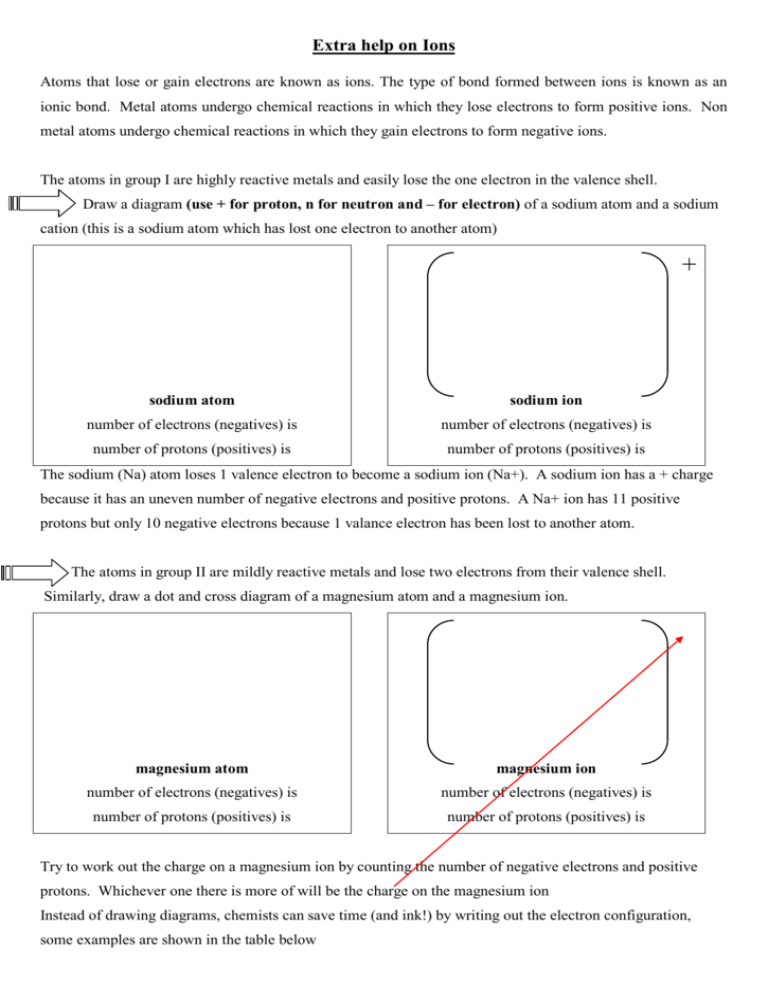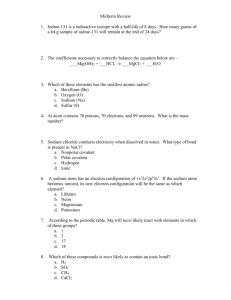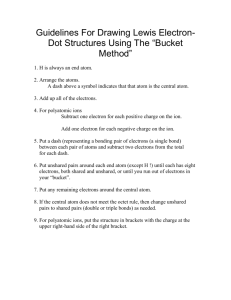Extra help on Ions - chemicalminds
advertisement

Extra help on Ions Atoms that lose or gain electrons are known as ions. The type of bond formed between ions is known as an ionic bond. Metal atoms undergo chemical reactions in which they lose electrons to form positive ions. Non metal atoms undergo chemical reactions in which they gain electrons to form negative ions. The atoms in group I are highly reactive metals and easily lose the one electron in the valence shell. Draw a diagram (use + for proton, n for neutron and – for electron) of a sodium atom and a sodium cation (this is a sodium atom which has lost one electron to another atom) + sodium atom sodium ion number of electrons (negatives) is number of electrons (negatives) is number of protons (positives) is number of protons (positives) is The sodium (Na) atom loses 1 valence electron to become a sodium ion (Na+). A sodium ion has a + charge because it has an uneven number of negative electrons and positive protons. A Na+ ion has 11 positive protons but only 10 negative electrons because 1 valance electron has been lost to another atom. The atoms in group II are mildly reactive metals and lose two electrons from their valence shell. Similarly, draw a dot and cross diagram of a magnesium atom and a magnesium ion. magnesium atom magnesium ion number of electrons (negatives) is number of electrons (negatives) is number of protons (positives) is number of protons (positives) is Try to work out the charge on a magnesium ion by counting the number of negative electrons and positive protons. Whichever one there is more of will be the charge on the magnesium ion Instead of drawing diagrams, chemists can save time (and ink!) by writing out the electron configuration, some examples are shown in the table below This means that the 1st shell of a sodium atom has 2 electrons, in the 2nd shell there are 8 electrons and outer shell there is 1 electron the electron configuration for a sodium atom is 2,8,1 This means that in the 1st shell of a sodium has 2 electrons, and in the 2nd shell (which is now the outer shell) there are 8 electrons. So, a sodium ion has lost 1 electron and has a positive charge the electron configuration for a sodium ion is 2,8 You may like to try writing out the electron configuration for atoms and ions, or skip below and continue to draw out dot and cross diagrams magnesium atom ____________________________ magnesium ion __________________________ so the charge on a magnesium ion is ________ calcium atom __________________________ calcium ion __________________________ so the charge on a calcium ion is ________ oxygen atom __________________________ oxide ion _________________________ so the charge on an oxide ions is ________ chlorine atom ___________________________ chloride ion ___________________________ so the charge on a chloride ion is ________ helium atom ________________________ argon atom _________________________ OR Draw a diagrams of a calcium atom and a calcium ion. calcium atom calcium ion number of electrons (negatives) is number of electrons (negatives) is number of protons (positives) is number of protons (positives) is Again, try to work out the charge on a calcium ion by counting the number of negative electrons and positive protons. Whichever one there is more of will be the charge on the calcium ion. Try to complete the diagrams below of anions (non-metals atoms that have gained electrons) The atoms in group XVI are mildly reactive non metals and gain two electrons. Draw a dot and cross diagram of an oxygen atom and an oxide ion. oxygen atom oxide ion number of electrons (negatives) is number of electrons (negatives) is number of protons (positives) is number of protons (positives) is Similarly, try to work out the charge on an oxide ion by counting the number of negative electrons and positive protons. Whichever one there is more of will be the charge on the oxide ion. The non-metals in Group XVII are highly reactive as they gain 1 electron. chlorine atom chloride ion number of electrons (negatives) is number of electrons (negatives) is number of protons (positives) is number of protons (positives) is Finally, try to work out the charge on a chloride ion. The noble gases are very unreactive as they already have a full outer shell, so they do not form ions. helium atom argon atom number of electrons (negatives) is number of electrons (negatives) is number of protons (positives) is number of protons (positives) is Charges on ions Atom Ion number of number of number of number or number of number of protons electrons neutrons protons electrons neutrons charge cation name of ion or anion? Li chloride Cl K Mg fluoride F Al Na oxide O Ca phosphide P Conclusion: I can see from my table that as atoms lose electrons they become ions with a _____________ charge because the ions have more __________________ in the nucleus. As atoms gain electrons they become ions with a ______________ charge because the ions have more ___________________in the valence shell. © 2013 http://www.chemicalminds.wikispaces.com







